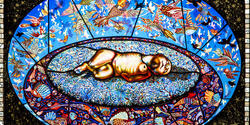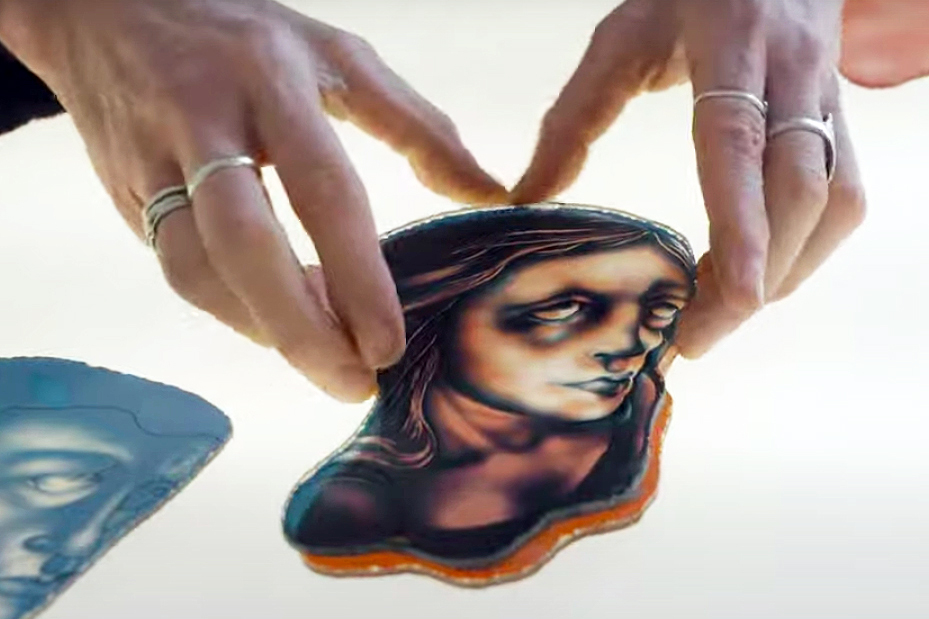Allegories in Glass

Pre-pandemic, Philadelphia-based glass artist Judith Schaechter 83 GL started this year on a high note, with major exhibitions making her work available to ever-growing audiences.
“I find the beauty of glass to be the perfect counterpoint to ugly and difficult subjects.”
Almost Better Angels, Schaechter’s winter solo show at Claire Oliver Gallery (which represents her) in NYC, drew great responses from visitors. And The Path to Paradise, her first major survey exhibition, went on view in mid February at the University of Rochester’s Memorial Art Gallery (MAG) in upstate New York.

Featuring 45 stained-glass panels and a selection of related drawings and process materials, the exhibition is on view (now digitally) at MAG through September 24 and will then travel to the Toledo [OH] Museum of Art and the Des Moines [IA] Art Center, pandemic-related protocols permitting. It’s also accompanied by an exhibition catalogue detailing her process and trajectory as an artist.
“I like to see what possibilities lie in mating difficult emotional ideas with sensuous but cruel materials.”
“When I first tried glass, the clouds parted and the angels came out,” Schaechter quips in a video made in conjunction with the Path to Paradise exhibition. “I like to see what possibilities lie in mating difficult emotional ideas with sensuous but cruel materials.”

In Schaechter’s richly detailed tableaus, animals are covered in blood and female protagonists appear to writhe in pain. Imagined bird species take wing against vibrant blue backdrops and explosions of multicolored flowers.
“My work is centered on the idea of transforming the wretched into the beautiful in theme as well as design,” she explains. “And I find the beauty of glass to be the perfect counterpoint to ugly and difficult subjects.”

The new exhibition catalogue describes Schaechter’s kaleidoscopic creations as “intentional seductions, alternative visions of beauty and radical statements of female experience.”
But the plainspoken artist says she’s just as likely to draw inspiration from Mad Magazine as from Renaissance masters, ancient mythology and medieval manuscripts.
Stained glass is “persuasive not because [of the] narratives but because the colors are overwhelming and the light is sublime.”


“I start my process with some sort of a sketch,” Schaechter says, “generating tons and tons of material before I actually make a piece.” The figures in her work are generally engaged in activities that are both ambiguous and universal.
“Schaechter’s genius is found in her unorthodox notions about the centuries-old tradition of stained glass, most often associated with medieval architecture and stories of Christianity,” says Toledo Museum curator Diane Wright. “She not only adds a new visual repertoire to stained glass but also applies innovative technologies to long-established methods.”

By layering different-colored pieces of flash glass on top of one another and creating a kind of sandwich, Schaechter is able to construct complex images using multiple hues. Where she deviates from traditional technique, she says, is in carving out shapes from each layered section, removing the surface color to reveal what’s underneath.

The results are captivating and have earned the artist multiple awards over the years, including a Guggenheim, two National Endowment for the Arts fellowships, a Louis Comfort Tiffany Award and recognition from the Joan Mitchell Foundation.
“I’m not a religious person, but I understand that the function of stained glass in a church or synagogue is to create radiant light,” Schaechter says. “It’s so persuasive not because the pictures are convincing narratives but because the colors are overwhelming and the light is sublime.”
—Simone Solondz
May 7, 2020